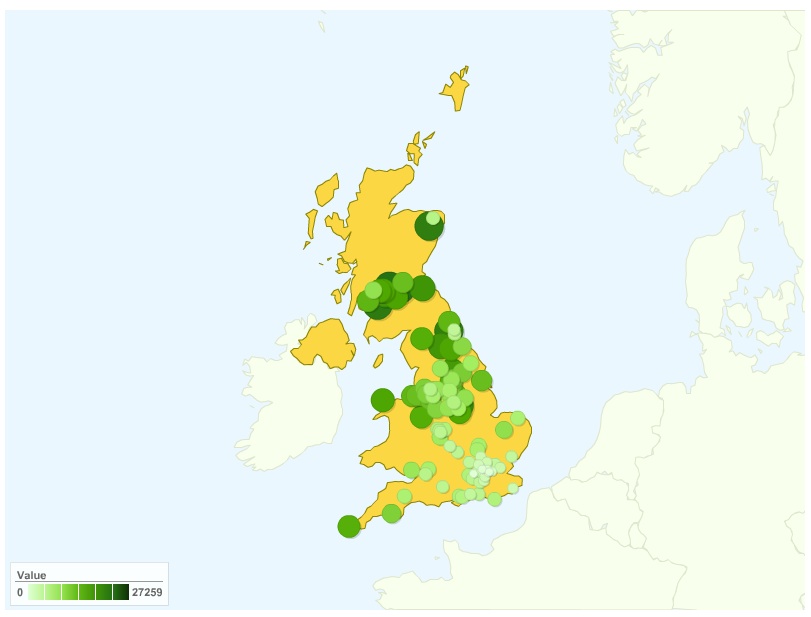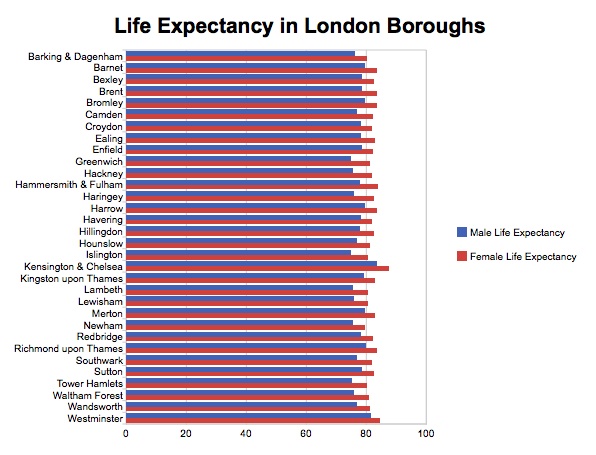Map Visualisation of MPs Travel Expenses
During Guardian Hack Day 2, Leigh ported the Guardian’s MP’s Expenses data into Talis. Most wonderfully, this gives a SPARQL endpoint that can be used to query the data. I thought I’d try to use the same approach as I blogged about recently, using a SPARQL query as a Data Source for a Google Visualisation of the MP’s expenses data.
To cut to the chase, here’s a screenshot of the result (follow the link for the more interactive version):

The Real Deal: data.gov.uk
I’m sure that you’ve noticed that my recent posts have been somewhat obsessed with publishing and using public sector information. It’s because I’ve somehow been sucked into the work going on within the UK government, with Tim Berners-Lee and Nigel Shadbolt advising, to publish its data as linked data.
My recent blog posts about publishing data using Talis have actually been a front for much more complex work that I’ve been doing with a different data set.
Opaque URIs != Unreadable URIs
I’ve been talking about URIs a lot recently. One of the things that has bothered me about some of the conversations is the conflation of the concepts of “opaque URIs” and “non-human-readable URIs”. This is my argument for keeping the concepts separate.
The opacity of URIs is an important axiom in web architecture. It states that web applications must not try to pick apart URIs in order to work out information from them. Applications must not, for example, use the fact that a URI has .html at the end to infer that it resolves to an HTML document. It’s closely related to hypertext as engine of application state, in that opaque URIs should not be generated by web applications either: they must be discovered through links and the submission of forms.
But this has nothing to do with readability or hackability, both of which are extremely important for human users. Readable URIs help human users understand something about the resource that the URI is pointing to. Hackable URIs (by which I mean ones that people might manipulate by altering or removing portions of the path or query) enable human users to locate other resources that they might be interested in.
Creating Google Visualisations of Linked Data
Update: For the people who couldn’t read the post because the graph didn’t have 0 as its x-axis minimum, here is the version of the graph that does. I haven’t removed the other version, since doing so would make the comments confusing and I think it’s interesting to compare the two.

There are idealists who immediately see the publication of Open Data as a Good Thing, and leap up and down (metaphorically or physically) shouting “Raw Data Now”. There are also a whole bunch of people who need to “see the shiny”. They need to understand why publishing Open Data is a Good Thing, and most particularly what the benefit is going to be to them.
This is understandable. Publishers bear the cost of the development of URI schemes, XML formats, RDF ontologies, and other infrastructure for serving data, and the ongoing maintenance cost of domain resolution, bandwidth usage and user support. Even publishers with a public-service remit (who may not need to see monetary payback) need to be convinced that there will be some kind of return on the investment.
One result of making data available is that it enables you and others to easily construct nice visualisations over the data, and maybe spot useful patterns within it. This is particularly useful for public sector information because it can provide feedback on how effective a particular policy has been or where more resources need to be spent.
So I thought it would be worthwhile trying to explore how to create visualisations of some data, starting with the London Borough data that I’ve published using Talis.
Versioning URIs
Yesterday I went along to a workshop on developing URI guidelines for the UK public sector. Because of the current drive to get more UK public sector information online, and the fact that we have Tim Berners-Lee on board, there’s a growing recognition of the fact that we need URIs for the real-world and conceptual things that we talk about in the public sector: schools, roads, hospitals, services, councils, and so on.
One of the particular points of contention at the meeting was whether URIs for non-information resources (ie for real-world and conceptual things) should contain dates or version numbers, or not.